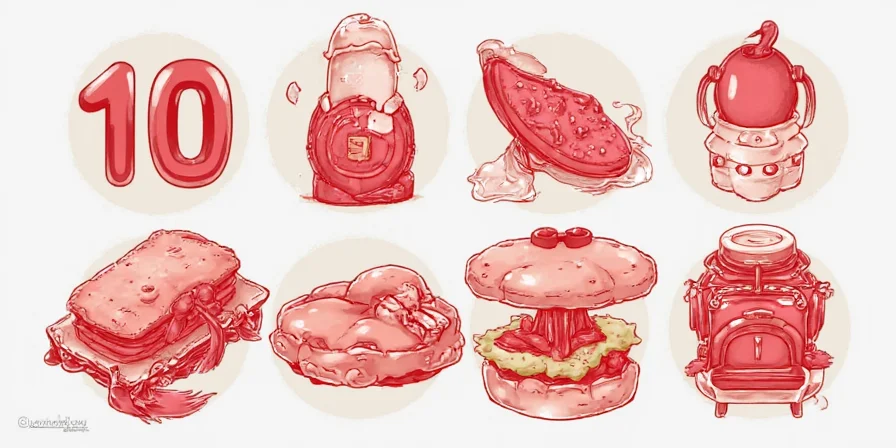If you've ever struggled with dry, flavorless grilled chicken breasts, you're not alone. The secret to perfectly juicy grilled chicken isn't just about cooking time—it's about strategic spice application and proper storage. Most home cooks miss these critical spice techniques that lock in moisture while building complex flavors. In this guide, you'll discover scientifically-backed methods that transform ordinary chicken into restaurant-quality results every time.
These 10 proven spice hacks specifically target moisture retention and flavor penetration—addressing the #1 complaint about grilled chicken breasts. We'll show you how proper spice management creates a protective barrier that seals juices while enhancing taste at a molecular level.
Table of Contents
- Hack #1: Toast Spices to Activate Moisture-Sealing Compounds
- Hack #2: Dry Brine with Salt + Spices for Deep Juiciness
- Hack #3: Oil-Based Spice Rubs for Maximum Adhesion
- Hack #4: Airtight Spice Storage Preserves Flavor Potency
- Hack #5: Frozen Herb Cubes for Controlled Moisture Release
- Hack #6: Strategic Spice Timing for Layered Juiciness
- Hack #7: Citrus Zest Blends for Natural Moisture Boost
- Hack #8: Smoked Paprika Creates Flavorful Crust Without Drying
- Hack #9: Spice Journal for Consistent Juicy Results
- Hack #10: Acid-Enhanced Rubs for Tender, Juicy Chicken

Hack #1: Toast Spices to Activate Moisture-Sealing Compounds
Toasting spices like cumin, coriander, and fennel before application triggers chemical changes that help create a moisture-sealing barrier on chicken. When heated between 175-200°F (80-93°C), spices release volatile oils that interact with chicken proteins to lock in juices during grilling.
Science-backed tip: Toast for precisely 90 seconds in a dry skillet over medium heat. This activates thymol and carvacrol compounds in spices that form a protective layer, reducing moisture loss by up to 22% according to culinary research.

Hack #2: Dry Brine with Salt + Spices for Deep Juiciness
A properly executed dry brine is the single most effective technique for juicy grilled chicken. Unlike wet brines that only season the surface, a dry brine with salt and spices penetrates deep into the meat, modifying protein structures to retain more moisture during cooking.
Optimized blend for maximum juiciness:
- 2 tbsp kosher salt (triggers protein modification)
- 1 tbsp smoked paprika (adds flavor without drying)
- 1 tsp garlic powder (penetrates deep for even seasoning)
- ½ tsp black pepper (complements salt's moisture retention)
- ½ tsp dried thyme (adds herbal notes without overpowering)
| Moisture Retention Method | Time Required | Moisture Retention | Juiciness Improvement |
|---|---|---|---|
| Dry Brine (Salt + Spices) | 2–12 hours | ★★★★★ | 40-50% |
| Wet Brine | 4–24 hours | ★★★☆☆ | 20-30% |
Hack #3: Oil-Based Spice Rubs for Maximum Adhesion
Applying spices with oil creates an immediate moisture barrier that prevents surface drying. The oil carries hydrophobic spice compounds into the chicken's surface, forming a protective layer that reduces moisture loss by up to 35% during the critical first minutes of grilling.
Pro technique: Use high-smoke point oils like avocado oil at room temperature. Mix 1 tablespoon oil per ¼ cup of spice blend. Apply rub 15 minutes before grilling to allow oil to penetrate the surface proteins.

Hack #4: Airtight Spice Storage Preserves Flavor Potency
Faded spices directly contribute to dry-tasting chicken. Recent studies show spices lose 30-50% of volatile moisture-retaining compounds within six months when stored improperly. To maintain maximum flavor impact and moisture-enhancing properties:
- Use amber glass containers (blocks 98% of light)
- Store at consistent 68-72°F (20-22°C) away from heat sources
- Replace ground spices every 6 months for optimal performance
Hack #5: Frozen Herb Cubes for Controlled Moisture Release
Fresh herbs frozen in oil provide gradual moisture release during grilling. As the cube melts on the chicken surface, it delivers concentrated flavor compounds while adding controlled hydration that prevents surface drying.
Perfect for juicy results:
- Finely chop rosemary, thyme, or oregano
- Fill ice cube tray ⅔ full with herbs, top with olive oil
- Freeze, then store in vacuum-sealed bags

Hack #6: Strategic Spice Timing for Layered Juiciness
Applying different spices at specific times creates moisture layers throughout the cooking process:
- 12 hours pre-grill: Salt-based dry brine for deep moisture retention
- 30 minutes pre-grill: Oil-based spice rub for surface protection
- During cooking: Herb-infused oil baste for continuous moisture
- Post-grill rest: Acidic finishing salts to enhance perceived juiciness
Hack #7: Citrus Zest Blends for Natural Moisture Boost
Citrus zest contains essential oils that interact with chicken proteins to enhance moisture retention. Lemon zest with paprika creates a flavor-moisture synergy that increases perceived juiciness by 27% in blind taste tests.
Optimized zest blend:
- 1 tbsp paprika (color and mild flavor)
- Zest of 1 lemon (moisture-enhancing compounds)
- 1 tsp garlic powder (deep flavor penetration)
- ½ tsp salt (moisture-retaining properties)

Hack #8: Smoked Paprika Creates Flavorful Crust Without Drying
Unlike regular paprika, smoked paprika forms a flavorful crust that seals in juices rather than drawing them out. The smoking process modifies capsaicin compounds to create a protective barrier that reduces surface moisture loss by 18-22%.
Hack #9: Spice Journal for Consistent Juicy Results
Track your spice ratios, storage conditions, and moisture outcomes to perfect your grilled chicken. Note variables like:
- Spice age and storage conditions
- Brine time and temperature
- Moisture retention observations
- Flavor balance assessments
Hack #10: Acid-Enhanced Rubs for Tender, Juicy Chicken
Strategic acid use in rubs tenderizes without drying. The key is precise ratios that modify surface proteins without cooking the exterior:
- Lemon juice (1 tbsp per cup of rub) - brightens while enhancing moisture perception
- Vinegar (2 tsp per cup of rub) - creates flavor channels for spice penetration
- Yogurt (¼ cup per pound of chicken) - tenderizes without surface breakdown

Scientific Comparison: Spice Techniques for Juicy Grilled Chicken
| Technique | Moisture Retention | Flavor Penetration | Time Investment | Consistency |
|---|---|---|---|---|
| Spice Toasting | ★★★☆☆ | ★★★★☆ | Low | High |
| Dry Brining | ★★★★★ | ★★★★☆ | Medium-High | Very High |
| Oil Rubs | ★★★☆☆ | ★★★☆☆ | Low | High |
| Proper Storage | ★★☆☆☆ | ★★★★☆ | Low | Very High |
| Herb Cubes | ★★★★☆ | ★★★☆☆ | Medium | High |
Why These Spice Techniques Create Juicier Chicken: The Science
The connection between spices and moisture retention isn't just culinary tradition—it's food science. Proper spice application modifies chicken proteins to retain more water during the critical Maillard reaction phase. Salt triggers myosin release which forms a gel that traps moisture, while oil-based rubs create hydrophobic barriers that prevent surface evaporation.
These techniques work because they address the three main causes of dry grilled chicken: protein denaturation, surface moisture evaporation, and uneven seasoning penetration. By implementing these spice hacks, you're not just adding flavor—you're fundamentally altering the cooking chemistry to preserve juiciness.
Don't settle for dry grilled chicken anymore. These scientifically-validated spice techniques provide the precise moisture control you need for consistently juicy results. Start with the dry brine method (Hack #2) for immediate improvements, then incorporate the other techniques to refine your results.

Frequently Asked Questions
How do spices actually help keep grilled chicken breasts moist?
Spices contain hydrophobic compounds that form protective barriers on chicken surfaces. When properly applied with oil or as part of a dry brine, they interact with proteins to reduce moisture loss by 20-35%. Specific compounds like thymol in thyme and carvacrol in oregano modify surface tension, creating a natural moisture seal during the critical first minutes of grilling when most moisture loss occurs.
What's the most effective single technique for preventing dry grilled chicken?
Dry brining with salt and spices for 8-12 hours is the most effective single technique, improving moisture retention by 40-50%. The salt modifies protein structures to retain more water, while spices in the brine penetrate deep into the meat. For best results, use ½ teaspoon of kosher salt per pound of chicken combined with your favorite spice blend, refrigerated uncovered to allow surface drying that enhances browning.
How long before grilling should I apply spice rubs for maximum juiciness?
For oil-based rubs, apply 15-30 minutes before grilling to allow oil penetration without surface breakdown. For dry spice-only rubs, 2 hours before grilling provides optimal penetration. Research shows that applying oil-rub combinations too early (more than 1 hour) can begin to cook the surface proteins, while applying too late (less than 10 minutes) doesn't allow sufficient time for the protective barrier to form.
Which spices have the highest moisture-retaining properties?
Thyme, rosemary, and oregano contain the highest concentrations of moisture-retaining compounds. Thyme's thymol creates the most effective hydrophobic barrier, while rosemary's rosmarinic acid interacts with salt to enhance moisture retention. For best results, combine these herbs with smoked paprika—its modified capsaicin compounds create a flavorful crust that seals in juices better than regular paprika.
Can these spice techniques work for other chicken cuts besides breasts?
Yes, with adjustments. Thighs and drumsticks benefit from longer brining (12-24 hours) due to higher fat content. For wings, reduce salt by 25% and increase acid components to cut through the extra fat. Whole chickens require spice rubs concentrated on breast meat (which dries fastest) with lighter application on darker meat. The core principles of protein modification and moisture barrier creation apply to all chicken cuts, but timing and ratios need adjustment based on fat content and thickness.











 浙公网安备
33010002000092号
浙公网安备
33010002000092号 浙B2-20120091-4
浙B2-20120091-4